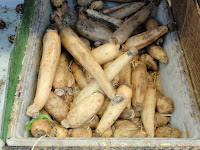
The lotus flower in Eastern religions is a symbol representing purity and divine wisdom. Seeded in muddy waters, the lotus rises above the mud and produces beautiful and fragrant flowers. As the level of the water rises, so does the flower, so although taking it's nourishment from the muddy water, it's beauty and fragrance is never tainted by it. In the same way, we can aspire to live in this world and maintain our purity and spiritual awareness.
All parts of the lotus plant are edible and commonly used in Asian countries, particularly China. The lotus leaves are used to season foods and also to wrap rice preparations for dim sum. The flowe
 rs are dried and used in dishes such as Mandarin Duck. The dried seeds are a commonly used food in China and Japan - they can be cooked with rice or other grain or bean dishes, added to soups and stews, made into a paste for use in sauces or as a cake filling. In Chinese medicine, the seeds, which are astringent with a sweet flavor are said to nourish the spleen, kidneys and heart. See http://www.itmonline.org/arts/lotus.htm for more info on lotus seeds as food and medicine.
rs are dried and used in dishes such as Mandarin Duck. The dried seeds are a commonly used food in China and Japan - they can be cooked with rice or other grain or bean dishes, added to soups and stews, made into a paste for use in sauces or as a cake filling. In Chinese medicine, the seeds, which are astringent with a sweet flavor are said to nourish the spleen, kidneys and heart. See http://www.itmonline.org/arts/lotus.htm for more info on lotus seeds as food and medicine.You might be forgiven for walking right by the hum
 ble lotus root in your Chinese
ble lotus root in your Chinese  Market. From the outside it doesn't look at all interesting (this picture was taken in Chinatown, LA), but when you cut into it, you will be happily surprised by the interesting lace like pattern of the inner flesh. It has a delicious slightly sweet flavor and crunchy texture which it maintains even when cooked. In my macrobiotic studies we learned about the use of lotus root to clear mucous from the lungs. A tea can be made from lotus root powder, to which you can add some grated fresh ginger juice. You can also grate the fresh root and squeeze the juice and add it to hot water along with some fresh squeezed ginger juice. Because of it's astringent nature and sweet flavor it is also nourishing to the liver, spleen and stomach. When cooked, the lotus root is said to build blood so is helpful to treat anaemia.
Market. From the outside it doesn't look at all interesting (this picture was taken in Chinatown, LA), but when you cut into it, you will be happily surprised by the interesting lace like pattern of the inner flesh. It has a delicious slightly sweet flavor and crunchy texture which it maintains even when cooked. In my macrobiotic studies we learned about the use of lotus root to clear mucous from the lungs. A tea can be made from lotus root powder, to which you can add some grated fresh ginger juice. You can also grate the fresh root and squeeze the juice and add it to hot water along with some fresh squeezed ginger juice. Because of it's astringent nature and sweet flavor it is also nourishing to the liver, spleen and stomach. When cooked, the lotus root is said to build blood so is helpful to treat anaemia. To cook lotus root, peel it and slice into discs. The flesh will discolor when sliced, so if not cooking it right away, you can pop it into a bowl of water to which you've added a squeeze of lemon juice. It's a little too fibrous to eat raw, but it can be blanched in lightly salted water to add to salads or cooked into many dishes. After my last trip to Chinatown, I made this dish which was quite delicious. Peel and slice your lotus root into thin slices. Finely mince about 1 Tbs. fresh ginger. Heat about 1 Tbs. olive oil in a large pan or wok and add lotus root, ginger and a big pinch sea salt and saute for several minutes. Add 1 - 2 Tbs. soy sauce, 1 Tbs. mirin, (you can use agave or rice syrup if you don't have mirin) and continue to stir saute for about 5 minutes. If it starts to stick to the pan you can drizzle in a little water. In the meantime, cut a head of broccoli into small flowerettes and peel and slice the stalks. Steam the broccoli or blanche in hot water until al dente. Add the broccoli to the lotus root and toss. Sprinkle with toasted sesame seeds before serving. To enhance the Asian flavor, you can drizzle with a tsp. of toasted sesame oil.
To cook lotus root, peel it and slice into discs. The flesh will discolor when sliced, so if not cooking it right away, you can pop it into a bowl of water to which you've added a squeeze of lemon juice. It's a little too fibrous to eat raw, but it can be blanched in lightly salted water to add to salads or cooked into many dishes. After my last trip to Chinatown, I made this dish which was quite delicious. Peel and slice your lotus root into thin slices. Finely mince about 1 Tbs. fresh ginger. Heat about 1 Tbs. olive oil in a large pan or wok and add lotus root, ginger and a big pinch sea salt and saute for several minutes. Add 1 - 2 Tbs. soy sauce, 1 Tbs. mirin, (you can use agave or rice syrup if you don't have mirin) and continue to stir saute for about 5 minutes. If it starts to stick to the pan you can drizzle in a little water. In the meantime, cut a head of broccoli into small flowerettes and peel and slice the stalks. Steam the broccoli or blanche in hot water until al dente. Add the broccoli to the lotus root and toss. Sprinkle with toasted sesame seeds before serving. To enhance the Asian flavor, you can drizzle with a tsp. of toasted sesame oil.NOTE: my friend who lives in Maine couldn't find fresh lotus root, but had some Mitoku, sun dried root which can be substituted for the fresh. Simply soak it for about two hours then drain and use.
Enjoy!

lovely goddess food, thanks for the post!
ReplyDelete